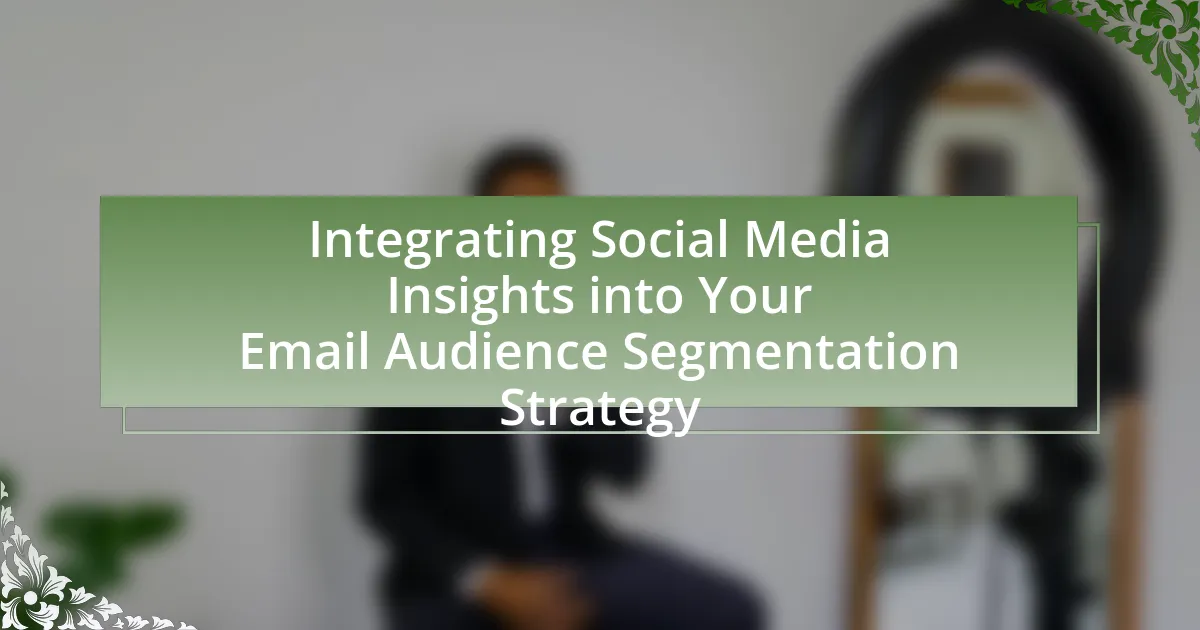Audience segmentation is a critical strategy in email marketing that significantly impacts open rates and engagement levels. By categorizing email lists based on demographics, behaviors, and preferences, marketers can create tailored content that resonates with specific audience segments. Research shows that segmented campaigns achieve open rates up to 14.31% higher than non-segmented ones, highlighting the importance of targeted messaging. The article explores how factors such as personalization, timing, and the various types of segmentation contribute to improved engagement metrics, while also addressing challenges marketers face in implementing effective segmentation strategies. Additionally, it discusses best practices and tools that can enhance email performance through continuous analysis and A/B testing.

What is the Impact of Audience Segmentation on Email Open Rates and Engagement?
Audience segmentation significantly enhances email open rates and engagement. By dividing an email list into specific groups based on demographics, behaviors, or preferences, marketers can tailor content to meet the unique interests of each segment. Research indicates that segmented email campaigns can achieve up to 14.31% higher open rates compared to non-segmented campaigns. This targeted approach not only increases the likelihood of emails being opened but also fosters greater engagement, as recipients are more inclined to interact with content that resonates with their specific needs and interests.
How does audience segmentation influence email open rates?
Audience segmentation significantly influences email open rates by allowing marketers to tailor content to specific groups, thereby increasing relevance and engagement. When emails are customized based on demographics, behaviors, or preferences, recipients are more likely to find the content appealing, leading to higher open rates. For instance, a study by Mailchimp found that segmented campaigns had an open rate of 14.32%, compared to 11.4% for non-segmented campaigns, demonstrating that targeted messaging effectively captures audience attention.
What factors contribute to higher open rates through segmentation?
Higher open rates through segmentation are primarily influenced by targeted messaging, relevance, and timing. Targeted messaging ensures that the content resonates with specific audience segments, increasing the likelihood of engagement. Relevance is achieved by tailoring subject lines and content to the interests and behaviors of each segment, which has been shown to improve open rates significantly. Timing plays a crucial role as well; sending emails when recipients are most likely to check their inbox can enhance visibility and engagement. Research indicates that segmented campaigns can lead to a 14.31% higher open rate compared to non-segmented campaigns, demonstrating the effectiveness of these factors in driving engagement.
How does personalization play a role in open rates?
Personalization significantly enhances email open rates by making content more relevant to individual recipients. When emails are tailored to reflect the preferences, behaviors, or demographics of the audience, recipients are more likely to engage with the content. For instance, a study by Experian found that personalized emails have an open rate 29% higher than non-personalized ones. This demonstrates that effective personalization strategies, such as using the recipient’s name or recommending products based on past purchases, can lead to increased engagement and higher open rates.
Why is engagement important in email marketing?
Engagement is crucial in email marketing because it directly influences the effectiveness of campaigns and the overall return on investment. High engagement rates, such as open and click-through rates, indicate that recipients find the content relevant and valuable, which can lead to increased conversions. According to a study by HubSpot, emails with personalized subject lines have a 26% higher open rate, demonstrating that tailored content significantly boosts engagement. Furthermore, engaged subscribers are more likely to become loyal customers, as they develop a stronger connection with the brand, ultimately enhancing customer lifetime value.
What metrics define engagement in email campaigns?
Metrics that define engagement in email campaigns include open rates, click-through rates (CTR), conversion rates, bounce rates, and unsubscribe rates. Open rates measure the percentage of recipients who open the email, indicating initial interest. Click-through rates assess the percentage of recipients who click on links within the email, reflecting deeper engagement. Conversion rates track the percentage of recipients who complete a desired action, such as making a purchase, showcasing the effectiveness of the email in driving actions. Bounce rates indicate the percentage of emails that could not be delivered, affecting overall engagement metrics. Unsubscribe rates reveal the percentage of recipients who opt out, providing insight into content relevance and audience satisfaction. These metrics collectively offer a comprehensive view of how well an email campaign resonates with its audience.
How does engagement affect overall marketing success?
Engagement significantly enhances overall marketing success by fostering stronger connections between brands and their audiences. High engagement rates lead to increased customer loyalty, higher conversion rates, and improved brand awareness. For instance, according to a study by HubSpot, companies that prioritize engagement see a 63% higher rate of customer retention. This correlation indicates that when audiences actively interact with marketing content, they are more likely to make purchases and advocate for the brand, ultimately driving revenue growth.
What are the different types of audience segmentation?
The different types of audience segmentation include demographic, geographic, psychographic, and behavioral segmentation. Demographic segmentation categorizes audiences based on characteristics such as age, gender, income, and education level. Geographic segmentation divides audiences based on location, which can influence preferences and behaviors. Psychographic segmentation focuses on the lifestyle, values, and interests of the audience, providing deeper insights into motivations. Behavioral segmentation analyzes consumer behaviors, such as purchasing patterns and brand loyalty, to tailor marketing strategies effectively. Each type of segmentation allows marketers to create targeted campaigns that enhance email open rates and engagement by addressing the specific needs and preferences of different audience segments.
How can demographic segmentation improve email effectiveness?
Demographic segmentation can significantly improve email effectiveness by allowing marketers to tailor content to specific audience characteristics such as age, gender, income, and location. This targeted approach increases relevance, leading to higher open and click-through rates. For instance, a study by Mailchimp found that segmented campaigns had an average open rate of 14.31%, compared to 11.4% for non-segmented campaigns. By aligning email content with the interests and needs of distinct demographic groups, marketers can enhance engagement and drive conversions more effectively.
What role does behavioral segmentation play in engagement?
Behavioral segmentation plays a crucial role in engagement by allowing marketers to tailor their messaging based on users’ actions and preferences. This targeted approach increases the relevance of communications, leading to higher open rates and interaction levels. For instance, a study by Mailchimp found that segmented campaigns can result in a 14.31% higher open rate compared to non-segmented campaigns. By analyzing behaviors such as past purchases, website interactions, and email engagement, businesses can create personalized experiences that resonate with their audience, ultimately driving greater engagement and loyalty.
How can audience segmentation strategies be implemented?
Audience segmentation strategies can be implemented by analyzing demographic, behavioral, and psychographic data to categorize an audience into distinct groups. This process involves collecting data through surveys, website analytics, and customer interactions, which allows marketers to identify specific characteristics and preferences of different segments. For instance, a study by Mailchimp found that segmented email campaigns can lead to a 14.31% higher open rate compared to non-segmented campaigns, demonstrating the effectiveness of targeted messaging. By tailoring content and offers to these segments, businesses can enhance engagement and improve overall email performance.
What tools are available for effective audience segmentation?
Effective audience segmentation can be achieved using tools such as Google Analytics, HubSpot, Mailchimp, and Segment. Google Analytics allows marketers to analyze user behavior and demographics, enabling targeted segmentation based on website interactions. HubSpot offers comprehensive CRM features that facilitate segmentation based on customer lifecycle stages and engagement metrics. Mailchimp provides segmentation options based on subscriber activity and preferences, enhancing email targeting. Segment specializes in collecting and organizing customer data from various sources, allowing for precise audience segmentation. These tools are widely recognized for their effectiveness in improving email open rates and engagement by delivering tailored content to specific audience segments.
How can businesses analyze their audience for better segmentation?
Businesses can analyze their audience for better segmentation by utilizing data analytics tools to gather insights on customer behavior, preferences, and demographics. By employing techniques such as surveys, web analytics, and social media monitoring, companies can identify distinct audience segments based on factors like purchasing patterns and engagement levels. For instance, a study by McKinsey & Company found that companies using advanced analytics for segmentation can achieve a 10-20% increase in marketing effectiveness. This data-driven approach enables businesses to tailor their marketing strategies, improving email open rates and overall engagement.
What challenges do marketers face with audience segmentation?
Marketers face several challenges with audience segmentation, primarily including data accuracy, evolving consumer behavior, and resource limitations. Data accuracy is crucial, as incorrect or outdated information can lead to ineffective targeting; for instance, a study by HubSpot found that 70% of marketers struggle with data quality issues. Evolving consumer behavior complicates segmentation, as preferences and interests can shift rapidly, making it difficult for marketers to maintain relevant segments. Additionally, resource limitations, such as budget constraints and insufficient tools, hinder the ability to analyze and segment audiences effectively, impacting overall marketing performance.
How can data privacy concerns impact segmentation efforts?
Data privacy concerns can significantly hinder segmentation efforts by limiting the data available for analysis and targeting. When consumers are wary of how their personal information is collected and used, they may opt out of data-sharing practices or provide inaccurate information, which directly affects the quality of segmentation. For instance, a survey by the Pew Research Center found that 79% of Americans are concerned about how their data is being used by companies, leading to reduced trust and engagement. Consequently, marketers may struggle to create effective segments, resulting in less personalized communication and lower email open rates and engagement.
What are common pitfalls in audience segmentation?
Common pitfalls in audience segmentation include oversimplification, neglecting data quality, and failing to update segments regularly. Oversimplification occurs when marketers create broad segments that do not accurately reflect the diversity within their audience, leading to ineffective targeting. Neglecting data quality can result in inaccurate segmentation, as poor data can misrepresent audience characteristics and preferences. Additionally, failing to update segments regularly can cause marketers to miss shifts in audience behavior or preferences, diminishing engagement and open rates. Research indicates that companies that regularly refine their audience segments see a 20% increase in engagement metrics, highlighting the importance of avoiding these pitfalls.
What best practices can enhance email open rates and engagement through segmentation?
To enhance email open rates and engagement through segmentation, marketers should implement targeted segmentation strategies based on user behavior, demographics, and preferences. By analyzing data such as past purchase behavior, engagement history, and geographic location, marketers can create tailored email campaigns that resonate with specific audience segments. For instance, a study by Mailchimp found that segmented campaigns can lead to a 14.31% higher open rate compared to non-segmented campaigns. Additionally, personalizing subject lines and content for each segment can significantly increase engagement, as emails that include the recipient’s name in the subject line have been shown to improve open rates by 26%. Therefore, effective segmentation combined with personalization is crucial for maximizing email performance.
How can A/B testing improve segmentation strategies?
A/B testing can significantly enhance segmentation strategies by providing data-driven insights into audience preferences and behaviors. By comparing two or more variations of content or targeting criteria, marketers can identify which segments respond more favorably to specific messages or offers. For instance, a study by Optimizely found that A/B testing can increase conversion rates by up to 300% when tailored to specific audience segments. This empirical evidence demonstrates that A/B testing not only refines segmentation but also optimizes engagement, leading to improved email open rates and overall campaign effectiveness.
What role does continuous analysis play in optimizing engagement?
Continuous analysis is crucial for optimizing engagement as it allows organizations to adapt their strategies based on real-time data and audience behavior. By consistently monitoring metrics such as open rates, click-through rates, and user interactions, businesses can identify trends and preferences within their segmented audiences. This data-driven approach enables targeted adjustments to content, timing, and frequency of communications, ultimately enhancing user experience and increasing engagement levels. For instance, a study by HubSpot found that personalized email campaigns, informed by continuous analysis, can lead to a 29% higher open rate and a 41% higher click-through rate compared to non-personalized campaigns.




